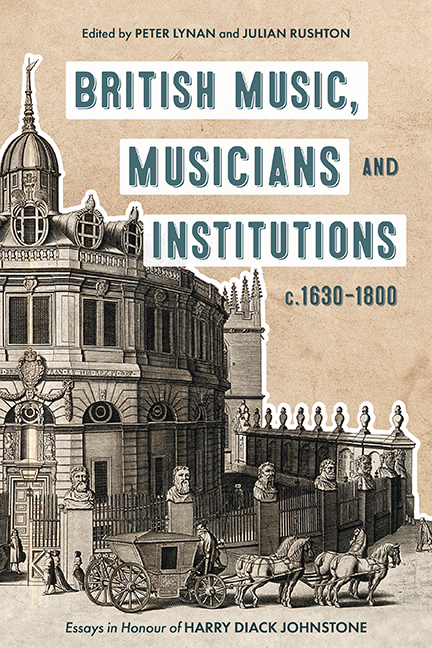Book contents
- Frontmatter
- Contents
- List of Illustrations
- List of Music Examples
- List of Contributors
- Acknowledgements
- List of Abbreviations
- Note to the Reader
- Introduction
- Part I Performers and Performance Style
- Part II Composers and Secular Institutions
- Part III Sacred Music and Institutions
- Part IV Dissemination: Copying, Printing, and Publishing
- Epilogue: Musica Britannica and the Eighteenth Century
- Harry Diack Johnstone: A Tribute
- Bibliography of the Publications of Harry Diack Johnstone
- Index
- Tabula Gratulatoria
10 - Catholic Church Music in Eighteenth-Century Britain
Published online by Cambridge University Press: 06 October 2022
- Frontmatter
- Contents
- List of Illustrations
- List of Music Examples
- List of Contributors
- Acknowledgements
- List of Abbreviations
- Note to the Reader
- Introduction
- Part I Performers and Performance Style
- Part II Composers and Secular Institutions
- Part III Sacred Music and Institutions
- Part IV Dissemination: Copying, Printing, and Publishing
- Epilogue: Musica Britannica and the Eighteenth Century
- Harry Diack Johnstone: A Tribute
- Bibliography of the Publications of Harry Diack Johnstone
- Index
- Tabula Gratulatoria
Summary
The ‘long eighteenth century’ (1688–1815) is perhaps not the most obvious time-frame for a survey of Catholic church music in Britain. Beginning with the ignominious flight of the Catholic James II and ending fourteen or so years before the ‘full’ emancipation of Catholics in 1829, it ushers in a period that to begin with is short on information and to all appearances lacking in significant musical activity, whereas the late eighteenth and early nineteenth centuries have already received a considerable amount of attention and might seem to merit little further study. During this time Catholics suffered severe disabilities, both civil and religious. Their civil disabilities, however, were not such as materially to affect religious life, and were similar in any case to those imposed on all women and on other groups including Protestant dissenters and Jews. As for the specifically religious restrictions, for example the embargo on public worship and on Catholic publications, the law was notionally severe but was only exceptionally enforced in all its rigour. The Acts of 1778 and 1791 introduced some elements of relief, but the road to the Act of 1829 was nevertheless beset with difficulties.
James II had created a full-scale Catholic Royal Chapel, parallel to the Anglican one, but his departure brought overt Catholic practice in England to an abrupt end. Charles II's widow, Catherine of Braganza, had moved to Somerset House in 1671, following the death of Henrietta Maria in 1669, although her chapel in St James's Palace (now part of Marlborough House) seems to have continued for a time in Catholic hands before being converted eventually to Anglican use. The practice of Catholicism, in London at least, then devolved on the chapels of the embassies of Catholic countries. As extra-territorial entities these could be frequented by English Catholics without penalty, although they were subject from time to time to mob violence.
The early history of the Catholic embassy chapels is not altogether clear. At first they will simply have been rooms within the embassy buildings themselves, and several remained so. From 1700 until 1708 the Portuguese had their embassy at Lincoln's Inn Fields. By 1715 a Sicilian embassy was established there, and this became the Sardinian embassy in 1720, when the Duke of Savoy exchanged his kingdom of Sicily (awarded at Utrecht in 1713) for Sardinia; the first reference to a ‘Sardinian’ chapel dates from 1722
- Type
- Chapter
- Information
- British Music, Musicians and Institutions, c. 1630-1800Essays in Honour of Harry Diack Johnstone, pp. 183 - 198Publisher: Boydell & BrewerPrint publication year: 2022



